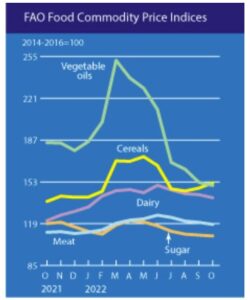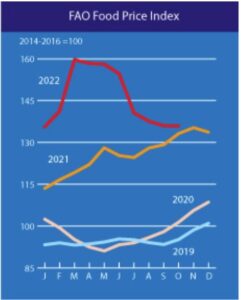Grains
The pressing issue around the Black Sea Grain Initiative caused uncertainty and fluctuations in the grain commodity market over the past few weeks. The deal brokered by the United Nations (U.N.) has been playing a crucial role in easing the global food crisis since July 2022, keeping prices sustainable while allowing upwards of nine million tons of grains to be exported from Ukraine.
On October 29, Russia abruptly withdrew from the agreement, a move that drove up wheat prices by nearly 6% on October 31, and many were concerned about global food shortages. Additionally, corn prices rose by 1.6% on the same day. Meanwhile, Russia rejoined the deal on November 2 after being persuaded by Turkey and the U.N. to continue permitting Ukrainian shipments across the Black Sea, although a long-term solution continues to look fragile.
Elsewhere, heavy rainfall in British Columbia, Canada, the second-highest exporter of wheat after Russia, has led to logistics and transportation challenges resulting in thousands of tons of wheat and canola stuck in grain terminals. According to the Canadian National Railway Company, at least 12 fully loaded unit trains totaling more than 100,000 tons at the Prairies have been awaiting deliveries as of November 5. Incessant rain has made it more difficult for terminals to load vessels as grains need to be kept from decaying or sprouting during the tranportation period. In the United States, low water levels on the Mississippi River has sent crop exports at Louisiana Gulf Coast terminals down to their their lowest level in nine years in early October, a period when export shipments typically accelerate.
With the expectation of a La Niña occurrence in South America between December and January, there is a possibility of drought in southern Brazil, the largest soy supplier in the world. In such a scenario, soybean production may be affected as it is expected to drop below 150 million tons in 2022-23.
Rice
The U.S. Department of Agriculture’s Foreign Agricultural Service (FAS) estimates rice output in India for 2022-23 to drop by 6% to 122 million tons ue to waterlogging from wet weather conditions. As the world’s second-largest rice producer and a leading exporter of more than 40% of global rice shipments, the price increase due to strong export demand amid low expected supply could affect many countries dependent on Indian rice. Meanwhile, authorities have permitted white and brown rice shipments that secured letters of credit issued before September 9 to be shipped overseas.
Palm Oil
The palm oil industry faces ambiguity in 2023 due to weather conditions, labor issues, and currency stability, with the Malaysia Palm Oil Board expecting potential supply disruption in the first quarter of 2023. Generally, however, prices and demand are expected to drop throughout the year in light of the current economic forecast, even amid lower production in Indonesia, the world’s largest palm oil producer ahead of Malaysia, in the past three years.
Sugar
Inclement weather conditions in Brazil have recently impeded sugar making, reducing supply amid continuous high demand. The situation is expected to worsen after India, the world’s second-largest producer of sugars, reduced the export quota to six million tons for 2022-23 from November 1 to May 31, 2023. According to the National Federation of Cooperative Sugar Factories Limited, sugar production in India was 14.73% lower than the previous year, with operating mills producing 405,000 tons of sugar in October.

